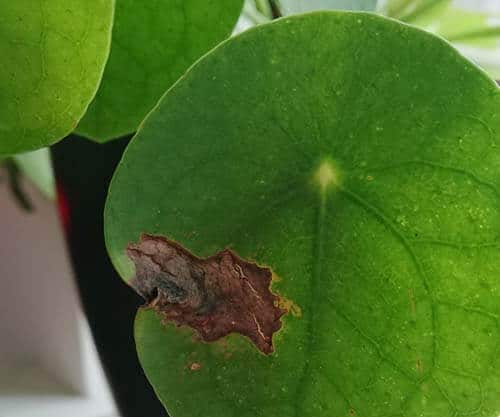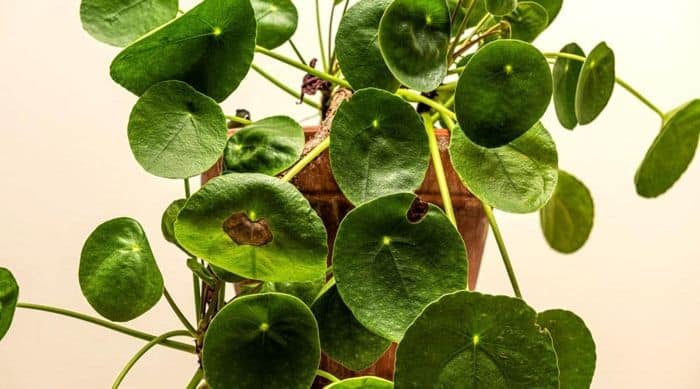Pilea plants are one of those plants that you can start to grow in your home or office. The reason is that this plant is relatively easy to grow and does not take much effort and money to care for. Pilea plants will captivate nature lovers with their vibrant green leaves.
During the process of growing and caring for plants, you may face a number of plant health problems. One of the most common diseases of Pilea plants is a condition in which leaves turn yellow or brown. Why is my Pilea turning yellow and brown? What should I do to treat and prevent this condition? All the details are already in the article below.
Why Is My Pilea Turning Yellow And Brown? Top 7 Common Reasons
The leaves of Pilea plants turning yellow or brown can be related to a variety of reasons. In particular, you need to pay attention to some of the basic causes such as excessive watering leading to waterlogging, fungal diseases, insect infestation, lack of water, lack of nutrients, or too much sunlight. Here are the common reasons and how to fix this situation.
Over-watering Leads To Waterlogging
Pilea plants are plants that are tolerant of many different living conditions. The times when this plant needs the most water are spring and summer. Because this is the growing season for Pilea plants, they will grow new and green leaves.
However, Pilea plants also cannot tolerate too humid environments due to excessive watering. In addition, poor drainage will cause waterlogging. Excess water will deplete the oxygen in the soil and cause serious health problems for plants.
If waterlogging occurs for a long time, the root system will suffocate and rot. As a result, the process of transporting water and absorbing nutrients from the root system will be destroyed. As a result, the leaves of the plant cannot remain green, instead, they will appear yellow and brown spots. Eventually, the yellow and brown spots will spread to the entire leaf and cause massive leaf shedding.
Solution for over-watering
First, you need to stop watering immediately and use measures such as opening drainage holes or changing the soil to remove excess water. If you find that root rot has become severe and a rotten smell is present, follow the steps below.
- Gently remove the entire plant from the pot.
- Remove yellow leaves, brown leaves, and root branches that are rotten or have root rot.
- Clean the root system with a solution that treats root rot and removes bacteria.
- Replace the new potting mix with perlite or gravel in the bottom layer to create openings. These openings will help remove excess water and better air exchange.
- Use soil-based pots to aid in the evaporation of water.
- The pot should have at least one vent hole to remove excess water.
- Move the potted plant to a sunny, well-ventilated area and avoid over-watering.
- You should only water when the ground is 2-3 inches completely dry and the plants show signs of needing water.

Watering Too Little
Another water-related cause is that too little watering causes plants to wilt. When Pilea plants do not receive enough water from the root system, the entire cells of the leaves and stems will have difficulty in photosynthesis and gas exchange. Under the sun, cells will be damaged and deformed causing yellow and brown spots to appear.
The leaves of the plant will dry out, wilt, droop around the pot, and fall off all at once. They often show signs of being rolled up, dry, and brittle. The reason is that the leaves of the Pilea plants have to be curled up to minimize the area exposed to the sun and to avoid evaporation from the cells on the leaves.
Solution for watering too little
You need to check the moisture in the soil with a moisture meter or use your finger to check. Water only when the ground is 2-3 inches dry and water in large amounts at a time until excess water has drained out of the vent. Here is the solution when your plants are suffering from severe water shortage.
- Move the potted plant to a shaded area and out of direct sunlight.
- Fill the pot with a large amount of water until the water has drained out of the vent.
- If the water shortage is severe, you can immerse the potted plant in a bucket of water so that the entire cells on the leaves and stem can absorb the water directly.
- Water continuously when the surface of the soil is dry because the Pilea plants need a lot of water to recover.
Bacteria Attack
The bacteria that attack Pilea plants will also cause their leaves to have yellow and brown spots to appear. Normally, these plants are not susceptible to disease, but if you grow them indoors, they are very susceptible to bacterial infections. Pseudomonas Cichorium is a common bacterium that causes leaf blight, yellow leaves, and stunted plant growth.
The infection usually attacks the veins of the stem and leaves. From there, the leaves of the plant are very susceptible to wilting, and yellow, brown spots will quickly cover the entire foliage. In wet conditions, the bacterial spots will quickly merge and create large yellow and brown patches on the entire leaf.
Solution for bacterial infection
Bacterial infections are often very contagious and spread quickly from leaf to leaf and from plant to plant. It is important that you cut this termite off and treat plants quickly by pruning diseased leaves and stems. You should also renew the pot and soil mix because bacteria can hide in the soil and continue to attack the plants. Here are some solutions you can take to treat and prevent infections.
- Avoid watering a lot that causes waterlogging to create conditions for bacteria to multiply and thrive.
- Do not mist or water the leaves at night because a humid environment is an ideal environment for bacteria.
- It is necessary to maintain a distance between the plants to create space for air circulation.
- Maintain ideal humidity, avoid too low humidity.
Fungal Diseases
Pilea plants are also susceptible to fungal diseases in wet conditions. Some fungi include gray mold (Botrytis blight), powdery mildew, Pythium root rot, and Myrothecium leaf spot disease. These fungi will directly attack the leaves of plants and interfere with photosynthesis and cause nutritional deficiencies. From there, the plants will grow stunted and the leaves appear in yellow spots and cook.
Fungal Leaf Spots: A common sign of plants being attacked by this fungus are brown spots with yellow borders on the leaves. Concentric circles may also appear on leaves. The yellow and brown spots will then fuse and create large yellow patches on the leaves.
Gray mold (Botrytis blight): This fungus causes blight and stunts plant growth. Small yellow spots with long streaks will appear on the entire leaf. Yellow and brown will quickly cover the entire plant. Meanwhile, the flowers will have orange or black streaks.
Powdery mildew: Powdery mildew will affect the growth rate of Pilea plants. The fungus will release fungal spores into the air, when the fungal spores attach to the leaves and cause necrotic spots on the leaves.
Solution for fungal diseases
- Remove infected leaves, stems, or roots with clean, disinfected tools.
- Use specialized fungicides to spray the entire plant.
- Avoid over-watering to create a humid and waterlogged environment.
- Provides nutrients to stimulate the growth of new leaves.
- Regularly clean the two sides of the leaves to remove fungal and bacterial spores that adhere to the surface of the leaves.
- Improve air circulation to avoid creating favorable conditions for fungi to grow.
Too Much Sun Exposure
Prolonged exposure to the sun can also cause yellow or brown leaves. If the leaves of Pilea plants are exposed to too much sun, their leaves will become pale or yellow. In addition, intense sunlight can also burn leaves and cause leaves to appear with brown spots or burnt and curled edges.
Solution for too much sun
Pilea plants are low-lying plants that cling to large trees to live. Therefore, the sunlight they receive is usually indirect sunlight or sunlight filtered through the foliage from the large trees above. Therefore, to limit exposure to too much sun, you need to pay attention to the following information.
- Place the potted plant in an area with indirect sunlight and a dry environment.
- Place about 1 meter away from the window and have a curtain to let the plants absorb enough sunlight and not get sunburned.
- Water regularly on high-temperature days to relieve stress on leaves as water vapor evaporates continuously.
- Rotate the pot at least every two weeks so that the plants can absorb enough sunlight and grow evenly.
Read this post: Black Spots On Pilea – Causes And Solutions
Insect Attack Causes Leave To Turn Yellow
One of the main culprits for the leaves of Pilea plants turning yellow or brown is insect damage. Some common insects include Aphids, Spider mites, and Mealybugs.
Aphids will suck the sap directly from the leaves and stems of plants. Then, they secrete a sweet juice and stimulate the growth of soot fungi. You can observe these bugs in several colors such as white, brown, black, green, and red. To deal with this insect, you just need to spray neem oil for 5-7 days to get rid of all aphids.

Spider mites will hide as white patches or spots on leaves and stem. When this insect attacks strongly, the foliage will turn partially or completely yellow. To get rid of spider mites, you need to clean both sides of the leaves with warm water. Then you spray insecticidal soap, neem oil, or insecticide all over the foliage.
Mealybugs will cause leaves to have white hairs on the undersides. These insects are small in size, so they are like dust particles clinging to leaves. In addition, when attacked by Mealybugs, the leaves of Pilea plants may appear with black mold spots. To get rid of this insect, you need to use a spray nozzle to remove the white patches on the leaves. Then, you spray alcohol on the entire foliage to get rid of this insect completely.
Lack Of Nutrients
Lack of nutrients in Pilea plants is also a common cause of the plant’s leaves turning yellow or brown. These brown spots are easily confused with potassium deficiency. If your plants lack nitrogen, the leaves will turn yellow and not be bright green. Leaves turning yellow can also be caused by an iron deficiency.
Solution for undernutrition
- Use specialized fertilizers for plants that include key ingredients such as nitrogen, potassium, phosphorus, or amino acids in the monthly fertilizer.
- Maintain soil pH in the range of 6.0 to 7.0 so that Pilea plants can best absorb potassium.
- Fertilize monthly during the growing season of plants.
- Use organic fertilizers or slow-release fertilizers to maintain nutrients in the soil.
Summary
The leaves of Pilea plants turning yellow or brown are related to many different factors. Some common causes include improper watering, watering too much or too little, exposure to too much sun, lack of nutrients, fungal diseases, bacteria, and insect infestation.
To overcome and prevent this situation, you need to regularly check the health of the plants. Water properly and avoid waterlogging that leads to root rot. Since then, the plant’s health is seriously affected, in addition, the humid environment will create favorable conditions for the growth of fungi, harmful bacteria, and insects to attack Pilea plants.